Taking advantage of connections to the county parks department, spring weather, and spring break, we tried a new program idea this spring. A Tree-mendous Mini Camp was held on two days in a local county park; we did a variety of tree-related activities, learning games, reading, crafting, and more. For two and a half hours each day on a Tuesday and Wednesday, we hosted a total of nearly 125 students, teachers, and parents to celebrate trees.
My library branch is in a community which includes two public school systems- a county system and a city system- as well as a number of parochial schools. While the county system was on spring break the week of the camp, the city schools had been on spring break the previous week. This worked out extremely well for us, as the entire 5th grade of one of the city schools used the opportunity for a field trip, arriving by school bus at the park for the program on Tuesday of the camp. They shared the experience with a few home school families, and with families enjoying their spring break. We had been worried about the weather on Tuesday, as it was cool and rainy. But with the field trip, attendance was great! Wednesday turned out to be a beautiful sunny day, which may have contributed to the crowd for that day. Some returned from Tuesday, but many on Wednesday were first time attendees. We chose the biggest shelter at the park for our location, which conveniently had restrooms attached (and also a source of both water and electricity) and a playground adjacent to it. Ample parking made the arrival of the bus easy, and gave us a hard surface for some of the activities, since the rainy weather made the grass wet and somewhat muddy.
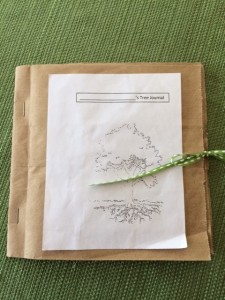 We started the morn
We started the morn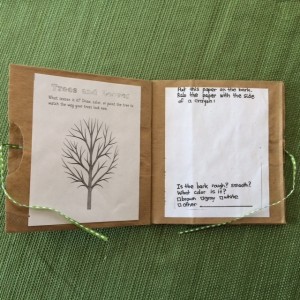 ing on Tuesday by creating a tree journal. The students created a folded lunch-bag journal, to which they attached photocopied tree journal pages. The pages included such things a space for leaf rubbings, bark rubbings, tree counts, drawings of tree observations, estimates of tree sizes, and more. The journals had ribbons attached for tying them closed, and the open end of the bag serves as a pocket for adding things to the journals at a later date. This activity was also repeated on Wednesday, for those who had not attended on Tuesday.
ing on Tuesday by creating a tree journal. The students created a folded lunch-bag journal, to which they attached photocopied tree journal pages. The pages included such things a space for leaf rubbings, bark rubbings, tree counts, drawings of tree observations, estimates of tree sizes, and more. The journals had ribbons attached for tying them closed, and the open end of the bag serves as a pocket for adding things to the journals at a later date. This activity was also repeated on Wednesday, for those who had not attended on Tuesday.
A variety of other tree-related activities took place over the course of the two days. The parks employee who co-hosted with me provided tree cookies- slices of tree branches- for each attendee to take home. We used these to talk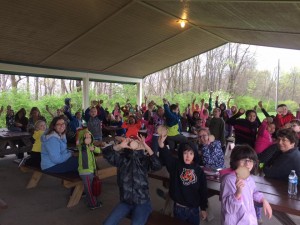 about tree rings; what they are, how to make inferences about the life of the tree from them, and how to figure out the tree’s approximate age. We also had tree trunk slices on hand to study, and provided magnifying glasses for counting rings, studying scars and marks, and for scrutinizing the bark on each. The tree cookies and large trunk slice provided by the parks department were from branches and trees that came down in the park system in a recent storm; trunk slices I brought with me came from trees cleared at my library for an ongoing building project.
about tree rings; what they are, how to make inferences about the life of the tree from them, and how to figure out the tree’s approximate age. We also had tree trunk slices on hand to study, and provided magnifying glasses for counting rings, studying scars and marks, and for scrutinizing the bark on each. The tree cookies and large trunk slice provided by the parks department were from branches and trees that came down in the park system in a recent storm; trunk slices I brought with me came from trees cleared at my library for an ongoing building project.
Topics included the life cycle of trees, why trees are important to us, s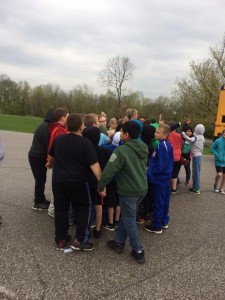 ome of the many things made from trees and tree materials, trees as habitats, tree identification, a tree variety relay race, and more. One activity provides a bunch of everyday items and students are asked to determine which come from trees or are made from trees. The trick is that all the items have tree materials in them… it’s surprising how many ordinary items come directly or indirectly from trees! A partial list can be found here: http://www.idahoforests.org/wood_you.htm
ome of the many things made from trees and tree materials, trees as habitats, tree identification, a tree variety relay race, and more. One activity provides a bunch of everyday items and students are asked to determine which come from trees or are made from trees. The trick is that all the items have tree materials in them… it’s surprising how many ordinary items come directly or indirectly from trees! A partial list can be found here: http://www.idahoforests.org/wood_you.htm
We also used the Tree Factory activity from Project Learning Tree to “build” trees from the inside out, using those in attendance as the parts of the trees. The activity we adapted from can be found here: https://www.plt.org/family-activity/tree-factory/ This particular activity we did both days. Those who attended both days enjoyed repeating the activity. It includes accurate vocabulary and scientific terms, as well as a lot of silly phrases and sounds. Kids and adults both have fun while learning with this activity! 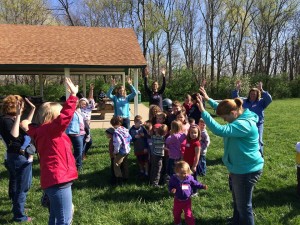
On Wednesday, we started by making recycled paper from construction paper pulp. I had the kids tear up construction paper into small bits, explaining that ordinarily this is a project I would do with left-over paper scraps; paper and water went in to the blender to make paper pulp. We used this opportunity to briefly talk about how paper is made. The kids then used the pulp to design their own paper trees, which were set aside to do some drying while other activities took place. Instructions for paper making can be found here: http://www.paperslurry.com/2014/05/19/how-to-make-handmade-paper-from-recycled-materials/ Instead of dipping our screens in the slurry, we spooned it onto the screens to make shapes.
At the end of each day, time was included to allow for looking through the variety of tree-related books brought from the library. Information about upcoming Parks and Library programs was provided. Students were also given time to make additional leaf rubbings with the rubbing plates. By the end of the two days, we had accomplished a total of 8 different tree activities, learned many things about trees, and had a lot of fun!

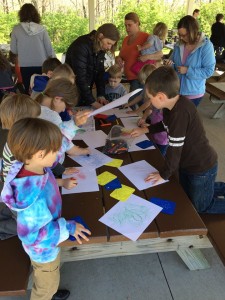



Leave A Comment